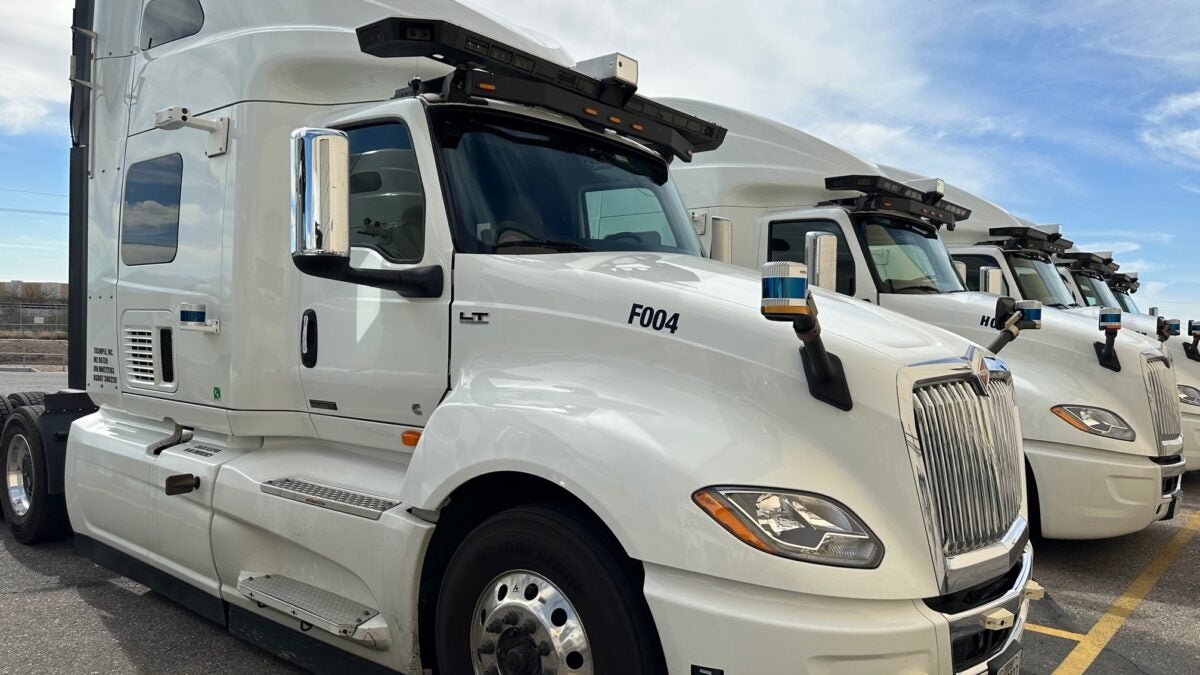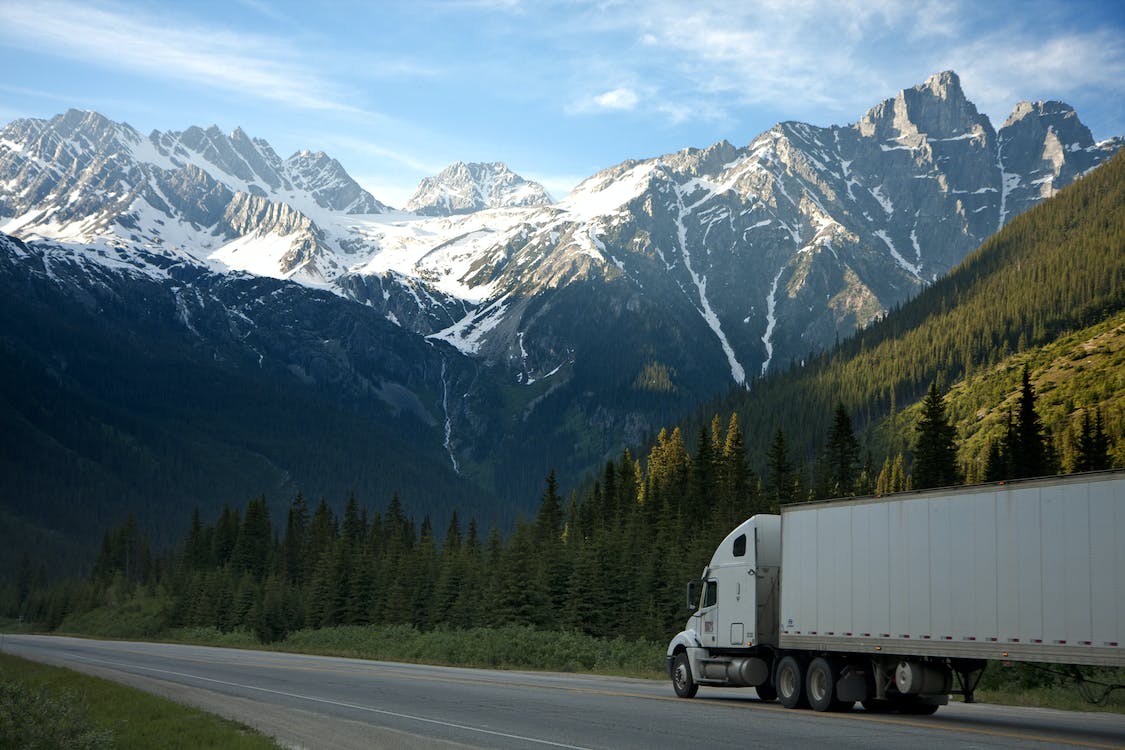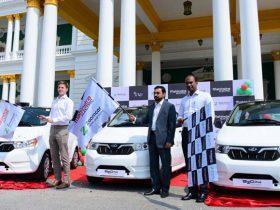Autonomous trucks tackle objects, run flawlessly in Pittsburgh track demos
By Alan Adler
After numerous rides in autonomous trucks monitored by safety drivers in case of a mishap, I found it almost surreal to climb into Aurora Innovation’s Class 8 driverless truck, buckle up, hear the engine rumble to life and the air brakes disengage, and feel the truck move under its own power — with no one in the driver’s seat.
While two of three Americans still fear autonomous vehicles, according to AAA’s latest survey released Thursday, my three-quarter-mile ride around an Aurora test facility southeast of Pittsburgh was in no way frightening. It was exhilarating.
I kept my iPhone camera trained on the steering wheel. It moved without prompts. Brakes slowed the tractor and empty 53-foot trailer into turns. The throttle engaged seamlessly, accelerating out of them.
Passenger cars and trucks pulled alongside and passed the truck, simulating real-world traffic. The Aurora Driver’s “big brain,” as Veer Nairyani, director of Aurora Driver, called it, anticipated their approach. Its 25 sensors calculated their moves and the truck’s reaction in nanoseconds.
The Peterbilt 579 equipped with the latest Aurora Driver system performed flawlessly. It held to the track-appropriate speed of 35 mph. Aurora tests semis at 65 mph on other tracks. It hauls scores of freight loads weekly on Interstate 45 between Dallas and Houston with safety drivers.
Showcase of roadway hazards
In a showcase of the truck’s constant computing of possible hazardous situations, Nairyani and Lia Theodosiou-Pisanelli, Aurora vice president of operations, narrated a series of possibly catastrophic events that could lead to a crash. The truck navigated aggressive cut-ins by other vehicles; a trash can and a tire littering the roadway; a pickup truck losing a mattress from its cargo bed in front of the truck; and a pseudo-pedestrian along the side of the road.
The show-and-tell ended with the truck striking a spike strip and blowing a tire. It stayed in control, pulling over to wait for help.
Analysts get their ride of a limetime
About 30 Wall Street analysts attended Aurora Investor Day on Thursday morning,. They climbed in and out of two trucks for their own ride of a lifetime. Aurora executives said the financial community is an important audience it needs to convince of the viability of autonomous trucking.
The Pittsburgh-based startup plans to field up to 20 driverless trucks on I-45 by the end of the year as it presses a leadership advantage bolstered by non-exclusive but deep partnerships with Paccar Inc., the parent of Peterbilt and Kenworth; and Volvo Group, which showed analysts a VNL chassis ready for Aurora Driver integration with integrated and centralized controls for braking, steering and propulsion.
If the thought of a loaded, 80,000-pound driverless truck sharing the road is scary — or perhaps unbelievable — take comfort in knowing it is neither.
https://www.youtube.com/embed/Y_ABAZKX8Tc?feature=oembed&enablejsapi=1&origin=https://www.freightwaves.comIt is cliche to write “Look Ma, no hands,” about the experience inside a moving Aurora Driver-equipped autonomous truck. But it is one appropriate expression for the wow factor of a three-quarter-mile ride with no human at the wheel.
Navistar reaches back for its autonomous trucking future
This week’s announcement that Traton Group brands Navistar, Scania and MAN are looking to Plus as the supplier of driverless technology for hub-to-hub operations shouldn’t be surprising.
The links between the two precede Navistar’s once industry-leading tie-up with TuSimple that ended in December 2022. Navistar has been testing the Plus Level 4 SuperDrive technology stack for about a year in Texas. A commercial pilot is planned late this year. For now, a human safety driver remains behind the wheel.
Work that Traton’s Scania brand had been doing in Sweden with TuSimple has flipped to Plus.
The wind down of TuSimple’s efforts in the U.S. to focus on China, Japan and Australia, and Plus’ U.S. emphasis on enhanced Level 2 driver assist features in recent years, cooled a rivalry that included some verbal skirmishing and some PR one-upmanship.
In August 2021, Plus released a video of a 20-mile driverless pilot it had conducted on a Chinese highway in June. That diverted attention from TuSimple’s anticipated “driver-out” experiment conducted on an 80-mile stretch of Interstate 10 between Phoenix and Tucson, Arizona, in December.

An early leg up
Ironically, Plus had an early leg up on TuSimple for the work it has now secured. Five years ago, then-Navistar CEO Persio Lisboa rode in an early version of a Plus-developed autonomous truck. That was before Traton acquired Navistar for $3.7 billion in October 2020.
As long ago as 2018, Denny Mooney, then-Navistar group vice president of product development, couldn’t contain his enthusiasm at saving 40% or more of fleet operating costs with robots taking over for human drivers.
Mooney left Navistar and became an adviser to Plus in 2020. In February 2021, he took the role of chief platform officer. His background likely helped Plus win the Navistar business. Navistar’s arrangement with TuSimple imploded around the time of a messy boardroom fracas at TuSimple.
The company was well along in developing a redundant chassis — backup brakes, steering and power required without a human driver to take control in case of a problem. TuSimple once held thousands of $500 deposits from fleets for an autonomous International LT-branded Class 8 truck.
Back in the game, but trailing the leaders
Toward the end of their 2 ½-year partnership, Navistar wasn’t communicating much with TuSimple, Jim Mullen, formerly TuSimple’s chief administrative and chief risk officer, told me.
While the Plus supply agreement gets Navistar back in the game, it trails Aurora Innovation, Kodiak Robotics and Torc Robotics in commercial readiness. Navistar is the fourth major truck maker to align with an autonomous developer. A shakeout last year sidelined Embark Trucks and Waymo Via.
Aurora has non-exclusive partnerships with Paccar Inc. and Volvo Group. Torc is an independent subsidiary of Daimler Truck. Each plans to install autonomous trucking hardware and software on its assembly lines. Navistar will integrate the Plus SuperDrive system in its factories later this decade.
With its global presence, Traton had its choice of suppliers for an autonomous system. Kodiak would have loved a tie-up since it relies on retrofitting its autonomous system on Kenworth T680s. It plans a commercial launch later this year in Texas.
“This is a nice deal for Plus to get the Navistar and Traton business,” Mullen said. “But if Navistar is looking at commercialization in 2030, they will be well behind the curve.”
Workhorse on the bubble
During the months Workhorse Group CEO Rick Dauch paused electric step van production in Union City, Indiana, while engineers developed a new W56 model from scratch, the company never laid off any workers.
Instead, they worked as painters and applied skilled trades to complete a $34 million makeover of the out-of-date factory. The plant rises from farm fields near the Ohio-Indiana border. Many of its workers came from farming families. Steady employment is a blessing.
This week, the reality of a slowdown in electric vehicle sales, partially due to a delay in implementing California’s Advanced Clean Fleets rule, led Workhorse to reverse its no-layoffs policy.
About 20% of the company’s employees were furloughed in a cash-saving move. Executives deferred 20% of their cash compensation until Q2. Workhorse included a notice of going concern — a warning that it might not make it through the next 12 months — in its 10-K filing with the Securities and Exchange Commission.
Alarm bells ring about Workhorse’s survivability
The alarm bells ring as the plant readies for single-shift production of 5,200 vehicles a year. Its EVs qualify for California’s generous vouchers.
“We have the products, supplier and dealer partners, engineering capabilities, business systems, and manufacturing processes in place to emerge as a winner in the Class 4 to 6 segment,” Dauch said on the company’s fourth-quarter conference call Tuesday. “But that only happens if fleet customers both large and small start buying our products in 2024.”
Workhorse had just $25 million in cash on hand at the end of 2023. The company is negotiating to sell the plant for $34.5 million and lease it back for $3.4 million a year for 20 years, according to its 10-K.
Workhorse is trying to raise money to scale the business. In addition to the W56, it upfits Greenpower Motors vehicles as the W750 chassis and has a contract to build Bulgarian-designed Tropos Class 1 delivery vehicles in the 100% manual operation.
“There’s no question that the transition to a new generation of powertrain technology is coming,” Dauch said. “The question is really when will it come.”
Link: https://www.freightwaves.com/news/auroras-driverless-trucks-show-they-are-for-real
Source: https://www.freightwaves.com
















Leave a Reply